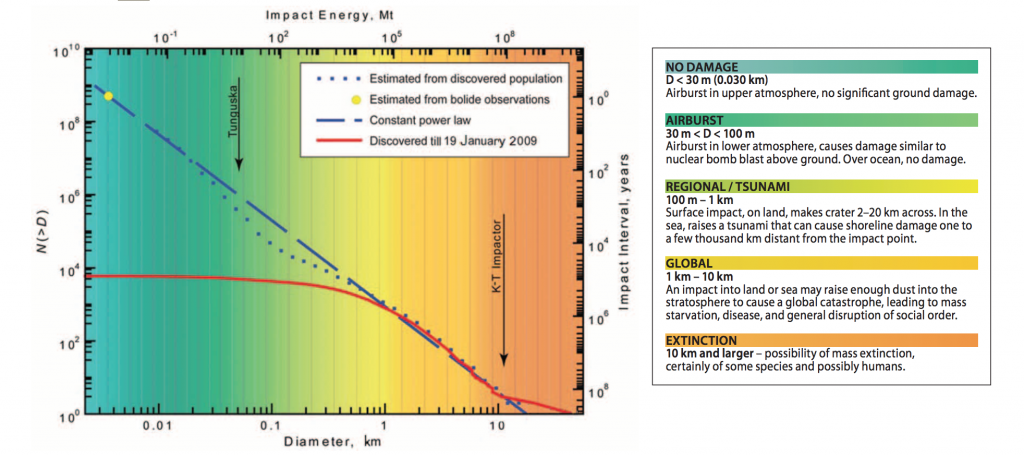The devastating consequences of impact events arose in the 1980s when the mass extinction event associated with the end of the dinosaurs was linked to the Chicxulub impact event. Understanding the frequency and environmental effects of impact events became essential in assessing the impact hazard. Fortunately for life on Earth, as seen in the image below, the occurrence of large size impactors that can cause large-scale extinction events are rare, on the order of hundreds of millions of years.

While the Cretaceous–Paleogene (K–Pg) boundary extinction event is the only impact event connected to a mass extinction event, understanding the frequency of NEOs colliding with the Earth is important in gauging the likelihood of an impact event affecting society. 2013 Chelyabinsk meteor, a ~20 m asteroid that caused significant damage to Russian city with the same name, demonstrates the need to understand affect impacts have on the environment.
Beyond the deformation of the target rock and formation of an impact structure, the entry of an impactor can cause significant damage through its atmospheric penetration, earthquakes, tsunamis, ejecta, dust, and the releasing of greenhouse gases. If an impact event was to take place over a large city the sonic boom produced alone would shatter windows and rock building as was seen in the Chelyabinsk incident. The damage, caused by earthquakes, ejecta and dust, is dependent on the size of the impactor. As the impact energy is dependent on the size of the impactor, the extent of the area that would be affected by a catastrophic earthquake, for example, will also depend on the amount of energy released. For large impactors, areas kilometers away from the ground zero could experience tremors and consequently damage to surface structures. This is also an important factor in the production of dust and ejecta, as the extent and amount of ejecta produced will ultimately depend on the size of the event. In the case of the K–Pg event, the climatic effect of launching a thick dust layer into the atmosphere is thought to have significantly cooled the Earth.
The production of ejecta and dust, along with the generation of greenhouse gases and tsunamis, is also strongly dependent on the target the impactor hits. For examples, if an impactor strikes a marine setting not only will it produce tsunamis, but it will cause large amounts of water to evaporate and be ejected into the upper atmosphere as water vapour. The water will then ionize in the upper atmosphere and produce compounds that readily destroy the ozone layer that protects the surface from harmful UV rays. If the target rock is rich in rocks that have carbonate phases, then the impact will cause the release of significant carbon dioxide and is able to significantly alter the concentration of greenhouse gases in the atmosphere eventually leading to climate change.
Due to the hazard of impact events, scientists continue to study the impact cratering process, the trajectory of NEOs and their potential threat. Fortunately for us, a K–Pg like event is unlikely to happen anytime soon, but the potential of events that could significantly damage cities is still possible and must be studied to better prepare us for such events.